
Ichneutica pagaia is a moth of the family Noctuidae. I. pagaia is endemic to New Zealand and can only be found on the Snares Islands. This species is unlikely to be confused with moths with a similar appearance as it is the only noctuid found in the Snares Islands. Its preferred habitat is tussock grasslands and the hosts for its larvae are likely Poa astonii and Poa tennantiana. Adults of this species are on the wing from November to February.

Ichneutica petrograpta is a moth of the family Noctuidae. This species is endemic to New Zealand where it is found in the southwest districts of the South Island, including Westland, Otago Lakes and Fiordland. It is very similar in appearance to I. mutans. It inhabits tussock and shrubland in the alpine to subalpine zones. Adults of I. petrograpta are on the wing from December to February and are attracted to sugar traps. The life history of this species is unknown as are the host species of its larvae.

Ichneutica acontistis is a moth of the family Noctuidae. It is endemic to New Zealand and is found only in the South Island, mainly on the eastern side although not in the Nelson district. This species is similar in appearance to I. paraxysta,I. stulta and I. toroneura. I. acontistis is unlikely to be confused with I. paraxysta as the later is only found in the North Island. I. acontistis can be distinguished from I. stulta as the latter species has a strongly curved forewing edge where as I. acontistis' is straight. I. acontistis can be distinguished from I. toroneura as the former has a dark stroke of colour starting from the base of the forewing that I. toroneura lacks. I. acontistis inhabits tussock grasslands and the larvae of this species feed on species of grass found in the genera Poa, Elymus and Rytidosperma. It pupates under rocks and adults are on the wing from September to January. I. acontistis are attracted to light.
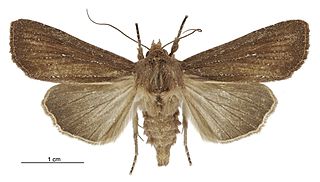
Ichneutica micrastra is a moth of the family Noctuidae. It is endemic to New Zealand. This species has been found only in the North Island and has been collected in the Northland, Auckland, Whanganui and Wellington regions. The preferred habitat of this species is wetlands and heathlands including gum fields in Northland. Adults of this species are on the wing from October to December. The life history of this species is unknown as are the host species of its larvae however it has been hypothesised that the likely larval host is a grass or grass like plant. This species is very similar in appearance to I. phaula and I. sapiens but can be distinguished as a result of differences in male antennae, the shape, colour and size of forewings, the range of the species as well as differences in genital shape.
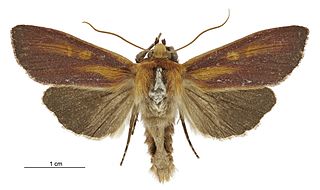
Ichneutica purdii, the orange astelia wainscot, is a moth of the family Noctuidae. It is endemic to New Zealand. It can be found throughout the main islands of New Zealand. I. purdii is a relatively large, colourful moth, unlikely to be confused with any other endemic moth species in New Zealand. The larvae of this moth feed at night on species of Astelia. During the day they shelter in the interior of the plant. When fully grown the larvae can reach a length of approximately 48mm. The larvae are ocherous in colour with a pink flush with line markings but when ready to pupate these markings fade and the larvae take on a light golden hue with a rosy tinge to its rear segments. The deep wine coloured pupa is enclosed in a slight cocoon, with this being constructed below the soil, amongst debris or alternatively within a hollow stick. The adult moths are on the wing from October to March. Although this moth is found throughout the main islands of New Zealand it is more frequent in the south of New Zealand at higher altitudes of up to 1200m.

Ichneutica eris is a moth of the family Noctuidae. It is endemic to New Zealand. It is found in alpine habitat in the South Island and is on the wing from November to February. The species is attracted to light.

Ichneutica falsidica is a moth of the family Noctuidae. This species is endemic to New Zealand and is widespread in the South Island but can only be found in the Tararua Range and Mount Taranaki in the North Island. This species is similar looking to I. panda but I. falsidica has dark dashes on their hind-wings. This species can be found open high country and has been seen flying during the day in sunny warm weather. At night adults are attracted to light. The life history of this species is unknown as are the host species of the larvae.
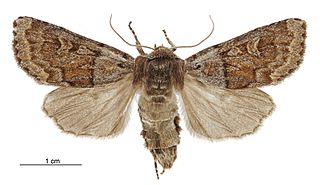
Ichneutica marmorata is a moth of the family Noctuidae. This species is endemic to New Zealand and can be found in the North Island at the Tongariro National Park and at Puketitiri near the Kaweka Range. In the South Island it is widespread. It prefers alpine to subalpine habitat but occurs down to sea level altitudes in more southern locations. Adults are on the wing from late October to February. Larvae of this species may use tussock grasses in the genus Chionochloa as their host and they have been reared on Festuca novae-zelandiae.

Ichneutica erebia is a moth of the family Noctuidae. This species is endemic to New Zealand and is found on Campbell Island and the Auckland Islands. Adults of this species are on the wing from August to January. The adults are variable in appearance but can be distinguished from similar species by the patters or lack thereof on their forewings. The larvae of I. erebia are polyphagous and hosts include Pleurophyllum criniferum, species within the genera Stilbocarpa and Carex, as well as Chionochloa antarctica, Urtica australis and Raukaua simplex.

Ichneutica chlorodonta, also known as the Green-toothed Owlet, is a moth of the family Noctuidae. This species is endemic to New Zealand. It is found throughout the North, South and Stewart Islands and is associated with native forest and shrubland. It can be confused with similar looking species such as I. subcyprea however I. chlorodonta can be distinguished through differences in colouration of its fore and hind wings as well as the length of the male pectinations. The life history of this species is unknown as are the host species of its larvae but adults of I. chlorodonta are on the wing from September to April.
Ichneutica dundastica is a moth of the family Noctuidae. This species is endemic to New Zealand. As at 2019 this species has only been found near the Dundas Hut in the Tararua Range near Wellington. It inhabits alpine shrubland and is attracted to light. The life history of this species is unknown as are the host species of its larvae however adults are on the wing from late November to early December. The female of the species is larger and more conspicuous than the male.
Ichneutica naufraga is a moth of the family Noctuidae. This species is endemic to New Zealand. It is only found on Big South Cape Island. The host of I. naufraga larvae is Poa foliosa, upon which the larvae feed at night. Adult moths have been recorded on the wing in November. This species can be distinguished from the visually similar I. mutans as both the male and female of the former species lack the distinctive dark marking that can be found on the forewings of I. mutans. The female I. naufraga is coloured a brown shade as opposed to the grey I. mutans and the male I. naufraga has longer antenna pectinations.

Ichneutica peridotea is a moth of the family Noctuidae. This species is endemic to New Zealand. The species is similar in appearance to Ichneutica plena but are more dull olive-green in appearance and the male lacks the patches of orange-brown forewing scales of the male I. plena. As at 2021 I. peridotera has only been collected in the Auckland District although Robert Hoare hypothesises that its range may include the northern districts of the North Island. The lack of information about this species is partially due to the fact it is late winter flying. The life history of this species is unknown as are the hosts of its larvae. Its preferred habitat is forest and the adults are attracted to light.
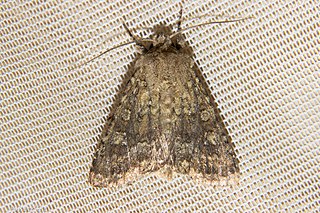
Ichneutica barbara is a moth of the family Noctuidae. This species is endemic to New Zealand and is only found in the South Island, more commonly on the eastern side of the South Island. This species has a grey forewing and is visually very similar in appearance to its close relative I. omicron. However the adult male of I. barbara has a yellow anal tuft in comparison to the grey tuft of I. omicron. In collections I. barbara has sometimes been confused with I. sistens. I. barbara appears to inhabit shrubland localities. The life history of this species is unknown as are the host species of the larvae but adults are on the wing from October to December.

Ichneutica cornuta is a moth of the family Noctuidae. This species is endemic to New Zealand and is only found in the South Island, in and around the Southern Alps. I. cornuta is very similar in appearance to pale forms of I. arotis. It is easy to confuse the two species as their ranges overlap. Male I. cornuta can be distinguished as it has longer pectinations on the antennae and the female lacks the dark scaling that can be found on the thorax of the I. arotis. There are also subtle differences in the forewing patterns of the two species. The life history of this species is unknown as are the host species of its larvae. Adults are on the wing from January to April.
Ichneutica theobroma is a moth of the family Noctuidae. This species is endemic to New Zealand. The males of this species has a pink chocolate brown appearance to its forewings with a small white dot. The males of this species can be distinguished from the 'northern dark form' of Ichneutica arotis as they have broader shaped forewings with less markings than the latter species. The females are extremely difficult if not impossible to tell apart. I. theobroma are found in the northern parts of the North Island and inhabit kauri forests. The life history of this species is unknown as are the host species of its larvae although it has been hypothesised that larval hosts include Gahnia setifolia and Gahnia xanthocarpa. Adults of this species are on the wing from mid September until early November and are attracted to light.
Ichneutica prismatica is a moth of the family Noctuidae. This species is endemic to New Zealand. The species is ochreous coloured with distinctive pale streaks on its forewings and a white fringe on its hindwings. It is similar in appearance to I. paraxysta but I. prismatica is smaller, lighter bodied and has narrower wings. Also I. prismatica can only be found in the South Island where as I. paraxysta is only known from the North Island. I. prismatica has mainly be collected in the Central Otago region but has also been recorded in the Otago Lakes and the wider Dunedin regions. It inhabits tussock grasslands and wetlands. The life history of this species is unknown but the larval host species are found in the genus Chionochloa. Adults are on the wing in December and January and have been recorded as flying during the day.
Ichneutica haedifrontella is a moth of the family Noctuidae. This species is endemic to New Zealand. It is only known from scattered areas in the North and South Islands. In the North Island it has only been collected in the Pouakai Range in Taranaki. In the South Island it is known from the Nelson, Buller, North Canterbury, Otago Lakes and Fiordland regions. It inhabits alpine to subalpine zones. The life history of this species is unknown as are the host species of its larvae in the wild. Larvae have been reared on species in the Chionochloa genus. Adults are on the wing from December to February and are attracted to light. This species has a smaller dwarf form that can be found in the Pouakai Range and at Dart Hut.
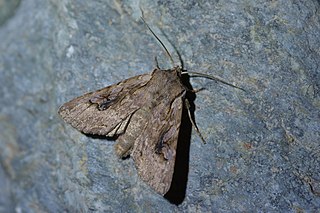
Ichneutica lindsayorum is a moth of the family Noctuidae. This species is endemic to New Zealand and can be found in the southern parts of the North Island and in the South Island. I. lindsayorum is very similar in appearance to I. olivea but has a longer basal streak and lacks the white scaling from the subterminal line on the forewing that can be found on the forewings of I. olivea. The life history of this species is unknown as are the host species of its larvae in the wild. However larvae have been reared on Ozothamnus leptophyllus. The adults of this species are on the wing from December to April.
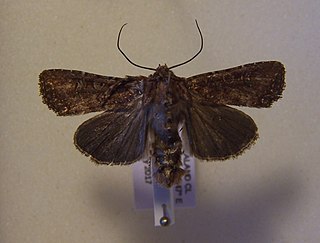
Ichneutica mustulenta is a moth of the family Noctuidae. This species is endemic to New Zealand is widespread throughout the North, South and Stewart Islands. I. mustulenta prefers damp native forest in the west of the North and South Islands. Its range only overlaps with its close relative I. morosa in a few places such as Taranaki. The life history of this species is unknown as are the host species of its larvae. However it is assumed that the larval hosts of this species will be grasses similar to its close relatives in the same genus. Adults of this species are on the wing from January to March.















